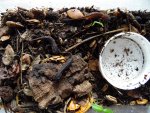JM29
Active member
Some species of salamander metamorphose at a small size. As such, it is sometimes difficult to provide small live prey with regularity and diversity that is appropriate.
After attempting to feed young Cynops ensicauda popei with springtails and fruit flies, I decided to try another method. For six weeks, I've been raising young newts on a substrate made by compost from my garden, rich in all kinds of small animals. I monitor my newts and I change the substrate when I notice their stomach is less plump. I've added no other food at the moment.
They are very dynamic and they grow well. Will come a time when this scheme will not be enough and I can go to earthworms.
This method could help ensure the first weeks after the metamorphosis for small species like Hypselotriton orientalis or Notophtalmus viridescens.
After attempting to feed young Cynops ensicauda popei with springtails and fruit flies, I decided to try another method. For six weeks, I've been raising young newts on a substrate made by compost from my garden, rich in all kinds of small animals. I monitor my newts and I change the substrate when I notice their stomach is less plump. I've added no other food at the moment.
They are very dynamic and they grow well. Will come a time when this scheme will not be enough and I can go to earthworms.
This method could help ensure the first weeks after the metamorphosis for small species like Hypselotriton orientalis or Notophtalmus viridescens.


